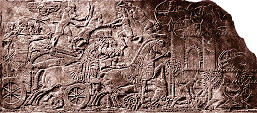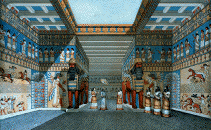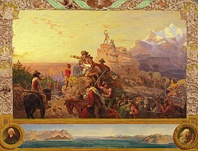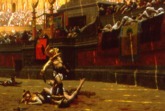

Examples of history painting:
Examples:

Mesopotamian, Nimrud, Ashurnasirpal II at War, c. 875 BCE, limestone relief, height 39 inches.
 Such relief sculptures lined the halls and
Such relief sculptures lined the halls and throne room of the king's palace. Many depicted historical scenes of the king dominating enemies and wild beasts. The panels are arranged in friezes — an innovation of Assyrian sculptors and architects. In the battle scene above, the Assyrian king Ashurnasirpal attacks a fortified city whose walls are defended by archers. A winged deity above the king both protects him and blesses the event. The Assyrians clearly have the advantage. See Mesopotamian art.

Nicolas Poussin (French, 1593/94-1665), The
Death of Germanicus, 1627, oil
on canvas, 58 x 77 3/8
inches, Minneapolis Institute of Arts. See Baroque.

Nicolas Poussin (French, 1593/94-1665), The Abduction of the Sabine Women, probably
1633-34, oil on canvas,
60 7/8 x 82 5/8 inches (154.6 x 209.9 cm), Metropolitan Museum
of Art, NY. (On the Met's page, you can enlarge any detail.)
Diego Velázquez de Silva (Spanish, 1599-1660).
Claude Gellée, known as Claude Le Lorrain (French, c. 1602-1682), The Disembarkation of Cleopatra at Tarsus, 1642, oil on canvas, 1.19 x 1.68 m, Louvre.
Charles Le Brun (French, 1619-1690), Alexander in Babylon, 1661-1665, oil on canvas, 4.50 x 7.07 m, Louvre.

John Singleton Copley (American
and British, 1738-1815), The Death of Major Peirson, 6 January 1781,
1783, oil on canvas,
251.5 x 365.8 cm, Tate Gallery, London. See flag.

John Singleton Copley, The Siege and Relief of Gibraltar, 13 September
1782, perhaps a replica,
c. 1783, oil on canvas,
134.6 x 189.9 cm, Tate Gallery, London.

Benjamin West (American, 1738-1820), Destruction
of the Beast and the False Prophet, 1804, oil
on panel, 39 x 56 1/2 inches, Minneapolis
Institute of Art.

Philip James De Loutherbourg (English, 1740-1812),
The Battle of the Nile, 1800, oil
on canvas, 152.4 x 214.0
cm, Tate Gallery, London.

Jacques-Louis David (French, 1748-1825),
The Death of Socrates, 1787, oil
on canvas, 51 x 77 1/4
inches (129.5 x 196.2 cm), Metropolitan Museum of Art, NY. (On
the Met's page, you can enlarge any detail.) See Neoclassicism.
Jacques-Louis David, The Oath of the Horatii, 1784, oil on canvas, 3.30 x 4.25 m, Louvre. See narrative art.

Jacques-Louis David, Sappho
and Phaon, 1809, oil
on canvas, 89 x 103 inches
(225.3 x 262 cm), Hermitage Museum, St. Petersburg, Russia.

John Trumbull (American, 1756-1843), The Sortie Made by the Garrison of Gibraltar,
1789, oil on canvas,
71 x 107 inches (180.3 x 271.8 cm), Metropolitan Museum of Art,
NY.

Sir Thomas Lawrence (English, 1769-1830),
Homer Reciting his Poems, 1790, oil
on canvas, 94.0 x 111.1
cm, Tate Gallery, London.
Théodore Géricault (French, 1791-1824), The Raft of the Medusa, 1819, oil on canvas, 4.91 x 7.16 m, Louvre. Géricault pictures a real-life drama of 149 shipwrecked sailors from the frigate "Medusa", abandoned for twelve days on a raft off the Senegalese coast. He chose to depict the moment on July 17, 1816 when the 15 survivors were overcome with despair as the "Argus", the ship that eventually was to rescue them, sailed off.
Eugène Delacroix (French, 1798-1863), The Massacre at Chios, 1824, oil on canvas, 4.19 x 3.54 m, Louvre.
George Caleb Bingham (American, 1811-1879), Daniel Boone Escorting Settlers Through the Cumberland Gap, 1851-52, oil on canvas, 36 1/2 x 50 1/4 inches, Washington University Gallery of Art, St. Louis, Missouri.

Emanuel Gottlieb Leutze (German-American,
1816-1869), Washington Crossing the Delaware, 1851,
oil on canvas,
149 x 255 inches (378.5 x 647.7 cm), Metropolitan Museum of Art,
NY. This painting depicts General George Washington's attack
on the Hessians at Trenton on December 25, 1776, during America's
revolution against England. A print published in 1853 gave the
painting the status of a national monument, in spite of numerous
errors in historical detail (the flag, for example, as depicted
here was not introduced until six months after the event). Nevertheless,
the painting captured and has held the affection of succeeding
generations of Americans, for the drama of the episode, despite
the histrionics, has great patriotic appeal. See flag.

Emanuel Gottlieb Leutze, Westward the Course of Empire Takes Its Way, 1861, oil on canvas, 33 1/4 x 43 3/8 inches, Smithsonian American Art Museum, Washington, DC. The painting's title, taken from a poem written in 1726 by Irish poet George Berkeley, became a motto for America's quest for Manifest Destiny — the 19th century drive to grow the nation over vast frontiers. Here a group of pioneers have just passed Native Americans to achieve the summit of a climactic, mountainous barrier. Leutze placed a panoramic view of their ultimate goal, San Francisco Bay, at the bottom of the composition, flanked by medallion portraits of William Lewis and Daniel Boone.

Jean-Léon Gérôme (French,
1824-1904), Pollice Verso (Thumbs Down), 1872, oil on canvas,
39.5 x 58.625 inches, Phoenix Art Museum. Gérôme
studied the architecture
of the Colosseum, along with other historical evidence in producing
this history painting. To the right of the imperial throne, the
vestal virgins indicate their desire for the death of a defeated
combatant. Light streaming between sections of the canopy can
be seen streaking across the floor and lower walls. Ridley Scott
(American, contemporary) has said that this picture inspired
his production of the movie Gladiator in 2000, starring
Russell Crowe and Joaquin Phoenix. See Roman art.
Johann Mongles Culverhouse (American, active 1849-1891), Death of DeSoto, 1873, oil on canvas, New Britain Museum of Art, CT.

Winslow Homer (American, 1836-1910), Prisoners from the Front, 1866, oil
on canvas, 24 x 38 inches
(61.0 x 96.5 cm), Metropolitan Museum of Art, NY. See Realism.
Thomas Hovenden (American, 1840-1895), The Last Moments of John Brown, c. 1884, oil on canvas, 46 1/8 x 38 3/8 inches (117.2 x 36.8 cm), Fine Arts Museums of San Francisco, CA. Compare this to the painting by Horace Pippin (American, 1888 - 1946), The Trial of John Brown, 1942, oil on canvas, 16 1/2 x 20 1/8 inches (41 x 51.2 cm), Fine Arts Museums of San Francisco, CA.
Horace Pippin (American, 1888-1946), The Trial of John Brown, 1942, oil on canvas, 16 1/2 x 20 1/8 inches (41 x 51.2 cm), Fine Arts Museums of San Francisco, CA. This and the following picture are most of a trilogy on the insurrection and execution of abolitionist John Brown. See African American art and history painting.

Grant Wood (American, 1892-1942), The Ride of Paul Revere, 1931, oil
on Masonite, 30 x 40
inches (76.2 x 101.6 cm), Metropolitan Museum of Art, NY. See
American Gothic.

Mark Tansey (American, 1949-), Forward Retreat, 1986, oil
on canvas, 94 x 116 inches,
Broad Art Foundation, Santa Monica, CA. See monochrome
and narrative
art. Also see several other works by Mark Tansey, each
a scene of historical fantasy, often art historical fantasy.
See sight.
Also see allegory, genres, and narrative art.
https://inform.quest/_art